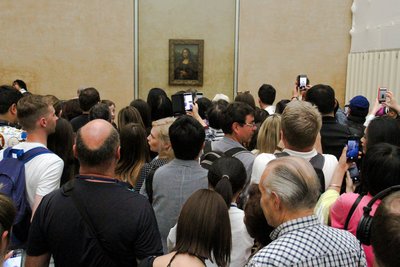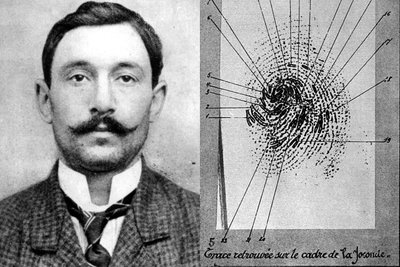In an instant, photos of the artwork traveled to newspapers almost all over the world, and the intensive search for the painting found itself in a new dead end.
Two years later, in December 1913, Peruggia was finally arrested, and the Mona Lisa returned to its rightful place, but already (even without the help of the almighty internet) the most famous painting in the world.
Today, the Mona Lisa is the crown jewel of the Louvre Museum in Paris, attracting millions of visitors to the museum each year, and a leitmotif that has recurred in both Andy Warhol's pop art and Dan Brown's popular book The Da Vinci Code.
If V. Peruggia had taken some other work of art from the museum under his work coat on that fateful day, history could have turned out very differently.
"If another Leonardo Da Vinci painting had been stolen back then, it would have become the most famous in the world, not the Mona Lisa," says Noah Charney, an art history professor and author of The Thefts of the Mona Lisa.
"Until it was stolen, the painting was nothing special - just a very good work by a very famous artist. The theft drastically increased its appeal and created a myth," he added.
So how did Peruggia pull off one of the most impressive heists of all time? At first glance, it seems very easy and smooth.

The Louvre hired the industrious craftsman to make protective glass covers for several of the museum's most famous exhibits, including the then-less-known"Mona Lisa." Hiding in a closet at night, the Italian calmly took down the painting he liked, hid it under his work coat, and was about to jump out of the museum when, to his great surprise, he realized that his door was locked and he couldn't get out.
In desperation, Peruggia dismantled the door handle, but the door still wouldn't open—until a helpful plumber, passing by, unlocked it with his key. The missing Mona Lisa was only reported missing a day later—no one immediately suspected, as works of art were often taken down for photo shoots or cleaning.
"The Louvre has over 400 rooms, but there were only 200 security guards. There were even fewer at night. There was basically no alarm system at that time. The museum was not properly guarded. In fact, like all museums of that time," says N. Charney, founder of the Association for Research into Crimes against Art.
An unexpected turn
The French media then did not miss the opportunity to mock such incompetent management of the Louvre Museum. It was a time when the influence of newspapers was growing every day, so very quickly the news of the theft – and the image of the Mona Lisa – went around the world. “Sixty detectives search for stolen Mona Lisa, French public outraged,” the New York Times reported at the time.
For the first time, queues formed at the Louvre - people wanted to see the empty space where the aforementioned painting by L. Da Vinci used to hang.
"It was precisely because of this theft that the Mona Lisa began to appeal even to those who had never been to Europe in their life and were not at all interested in art. And that was just the beginning," N. Charney tells the incredible story of the painting's rise to popularity.
The next two years were difficult and exhausting for the police officers, the investigation dragged on, and more than once it seemed that they would not be able to break the deadlock. There was a time when Pablo Picasso was considered a suspect. Interestingly, the officers even questioned V. Peruggia himself twice, but concluded that he could not really be responsible for this brazen theft.
One of the most unexpected twists in the investigation involved Pablo Picasso, who was questioned about the theft. Although Picasso did not steal the Mona Lisa, it turned out that he was involved in an earlier theft from the Louvre: he had purchased a pair of ancient Iberian statue heads that had been stolen from the museum a few years earlier and handed them over to the police, fearing prosecution in the Mona Lisa case.

"Strange Man"
The Paris police chief retired in disgrace. And then, two years later, an art dealer in Florence received a letter from someone claiming to have the Mona Lisa. The painting was supposedly signed by Da Vinci himself. The person, it turned out, was Peruggia.
Peruggia arranged to meet the art dealer at the Uffizi art museum in Florence. The thief brought with him the painting, which he had been hiding in a suitcase in his apartment all this time.
Peruggia, then 32, said he stole the painting to bring the Mona Lisa back to his native Italy. He was arrested and eventually sentenced to seven months in prison.
"He seemed to genuinely believe that he would become a national hero for what he had done, and he was very disappointed when that didn't happen. He was a strange man, but he was certainly not crazy," Charney added.
Ordinary people can only see the mysteriously smiling Mona Lisa by sneaking past other curious onlookers – and then only through bulletproof glass and from a certain distance. But V. Peruggia even had two of the paintings for himself. Did he fall in love with the girl depicted in them?
"I think so. Surely more than one thief who has appropriated a work of art has experienced a kind of reverse Stockholm syndrome - when a hostage taker falls in love with a hostage. In this case, that hostage was a work of art," N. Charney reasons.
So priceless that it's even worthless
The Mona Lisa is now perhaps the most famous work of art in the history of art. Interestingly, the painting is worth exactly 0 euros.
And it’s certainly not because there is no demand for the painting. And it’s not because there won’t be a buyer willing to pay a lot for it. The reason is different – the Mona Lisa simply isn’t for sale. It can’t be sold – legally, politically, or economically. The painting is considered a French national treasure, so it’s permanently off the market, unbanned, and so priceless that it’s even worthless. The fame and notoriety that artists and brands could only dream of – in this case, doesn’t create any financial benefit for the object.
Most people think that you can put a price on absolutely everything. Especially in the art world, where private sales and record auctions run into the hundreds of millions. But the Mona Lisa exists outside of this system. A painting is not a commodity – it is an intangible object.
Under French law, the Mona Lisa is classified as inalienable public property. This means that the painting is part of France's national heritage and cannot be sold, exported, or removed from the Louvre Museum's collection under any circumstances.
The Mona Lisa is not property, but a state symbol.
But even if a buyer were to offer $10 billion for the painting, there is simply no mechanism to accept the offer. No court, no government agency, and no museum board has the authority to transfer ownership of the painting. The Mona Lisa does not belong to the Louvre—the painting belongs to France.
It is also paradoxical that the painting is not insured.
Why? Because it is impossible to determine the amount of insurance compensation for an item that cannot be restored and sold. Traditional insurance models rely on the replacement value of the property or comparable market prices. Neither is suitable for the Mona Lisa. L. da Vinci is incomparable, so there can be no question of any replacement value.
The Louvre has not insured the painting because there is no insurance company that could conclude a practical or financially sensible insurance contract in this case.

